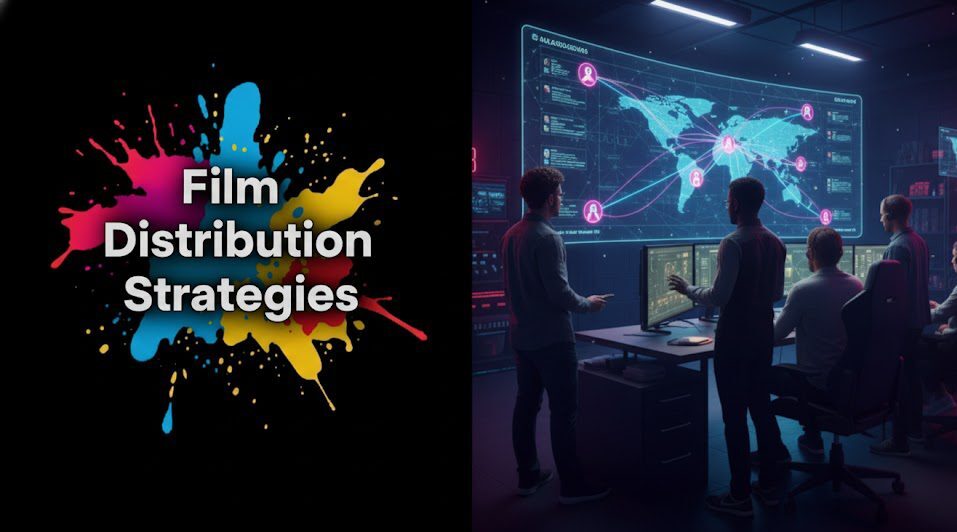5 Proven Film Distribution Strategies That Work in 2025

Introduction
The market for monetization and audience reach is no longer defined by a simple sequence of windows. For content acquisition and distribution executives, success in 2025 demands a sophisticated, data-first approach that treats distribution not as a logistical endpoint, but as a continuous commercial strategy.
The era of the predictable 90-day theatrical exclusive is over, replaced by a dynamic, fragmented landscape where a title’s profitability is determined by the speed, precision, and alignment of its multi-platform release plan.
Film Distribution Strategies must now be viewed through the lens of maximizing value across the entire asset lifecycle, from pre-sale financing through global ancillary rights.
This guide provides an executive-level breakdown of the five non-negotiable strategic pillars that will drive success and ROI in the current entertainment entertainment supply chain.
Table of content
- Strategy 1: Mastering the Accelerated Theatrical Window
- Strategy 2: Navigating the VOD Stack (SVOD, TVOD, and AVOD Models)
- Strategy 3: The Data-Driven Acquisition Engine
- Strategy 4: Pre-Sale, Global Financing, and International Sales Agents
- How Vitrina Transforms Film Distribution Strategies with Data
- Conclusion: Executing a Holistic Distribution Plan
- Frequently Asked Questions
Key Takeaways
| Core Challenge | The M&E supply chain is fragmented, making it nearly impossible to vet potential distribution partners, track pre-sale financing, and align a release strategy with a film’s true market potential. |
| Strategic Solution | Move beyond traditional market intelligence to adopt a comprehensive, data-driven project tracking system that provides real-time visibility into global projects, companies, and decision-makers. |
| Vitrina’s Role | Vitrina provides the structured intelligence needed to scout, vet, and connect with ideal distribution partners globally, reducing deal friction and enabling accurate pre-acquisition analysis. |
Strategy 1: Mastering the Accelerated Theatrical Window
Theatrical release remains a critical component of any premium content strategy, acting as the primary marketing event that establishes brand value and drives subsequent platform licensing deals.
However, the traditional 90-day exclusivity period is effectively obsolete for all but the highest-budget blockbusters. The core strategy for 2025 is the precise management of accelerated windows, typically ranging from 17 to 45 days, to maximize box office returns while capitalizing quickly on the subsequent VOD release.
This strategy hinges on a calculated risk assessment: how much box office revenue is sacrificed by shortening the window versus the value gained from a rapid entry into transactional VOD (TVOD) and subscription platforms.
For example, mid-budget genre titles often benefit from a compressed window, allowing the film to leverage theatrical buzz directly into high-intent digital purchases. This approach requires rigorous negotiation with exhibition partners and an agile content delivery system.
Furthermore, effective windowing involves counterprogramming—the deliberate positioning of niche titles against major studio tentpoles to capture underserved audiences. Success is measured not by overall box office size, but by the efficiency of the box office recoupment relative to the Print & Advertising (P&A) spend.
The critical decision point is determining the optimal theatrical footprint. A national wide release may no longer be the most profitable option.
Instead, a targeted theatrical run in key metropolitan areas that correlates highly with the film’s established audience demographic can generate the prestige and initial critical mass required to validate its performance to downstream buyers.
This selective approach requires distribution executives to identify regional exhibitors with high-performance metrics for comparable titles, a task that demands granular, company-specific intelligence. The days of treating all theatrical partners as homogenous entities are gone.
Strategy 2: Navigating the VOD Stack (SVOD, TVOD, and AVOD Models)
The digital distribution landscape is a complex stack of monetization tiers: SVOD (Subscription Video On Demand), TVOD (Transactional Video On Demand), and AVOD (Advertising Video On Demand).
A leading Film Distribution Strategies framework must treat these tiers as interconnected monetization windows rather than discrete options. The key is in sequence and selection, maximizing the value extraction from each phase of the film’s lifecycle.
TVOD offers the highest revenue per transaction and is the ideal first digital window, typically opening shortly after or concurrently with the end of the limited theatrical run.
The goal is to capture the initial, high-intent audience willing to pay a premium. SVOD serves as the critical second window, providing a substantial licensing fee and global reach.
Strategists must evaluate SVOD partners based not just on the upfront license fee, but on their geographic reach and ability to position the title within a relevant catalogue. For titles with established IP or star power, a strong SVOD deal guarantees mass accessibility.
Finally, AVOD has emerged as a powerhouse for deep catalogue monetization and for regional titles seeking mass, ad-supported reach. Companies are increasingly finding that free, ad-supported streaming television (FAST) channels and other AVOD platforms provide significant long-tail revenue.
The strategic decision for content owners is whether to sign a title to an exclusive SVOD deal, which may limit subsequent AVOD revenue, or to retain more rights for a strategic layering of windows.
Executing the transition between these windows requires strong contracts and a clean chain of title for Distribution and Licensing across territories. A title’s performance in one model directly impacts its negotiation value in the next, necessitating a fluid, adaptable plan.
Strategy 3: The Data-Driven Acquisition Engine
In 2025, successful distribution is synonymous with data-driven acquisition. The executive mandate is to move away from relying solely on instinct, personal relationships, or historical performance toward a model powered by predictive analytics and real-time market signals. This shift involves leveraging data throughout the content lifecycle, from development to post-release analysis.
Data analytics informs a successful distribution strategy in two key areas. First, it enables precise audience targeting by analyzing genre consumption trends, viewing demographics, and regional preferences to determine the most effective release strategy.
Knowing who will watch the film dictates where and when it should be released. Second, it drives smarter acquisition decisions. As Variety reports, the use of algorithms to recommend films based on viewing history and genre preferences has become standard for major streamers, and distributors must follow suit.
This requires gathering hard evidence on a title’s potential, including the track record of the production company, the director’s performance with similar themes, and the proven commerciality of the key cast and crew in specific global territories.
By tracking project movement early, executives can identify emerging titles and secure pre-buys before the market is saturated. The goal is not merely to track box office trends, but to utilize data-driven acquisition principles to identify a film’s intrinsic value before it is fully marketed, giving the buyer a critical advantage in negotiations.
This holistic view of project movement and the participants involved is essential for modern risk mitigation in the high-stakes world of content finance. This capability is rapidly becoming the single greatest differentiator between market leaders and followers.
Strategy 4: Pre-Sale, Global Financing, and International Sales Agents
For many independent and mid-tier films, the true distribution strategy begins not at release, but during the financing stage through pre-sales. Pre-sale financing is a strategy where a producer sells the distribution rights for specific international territories or media windows (e.g., VOD rights in Germany) before the film is completed.
The guaranteed revenue from these pre-sales serves as collateral for production financing, effectively funding the film before a frame is shot.
This strategy is entirely dependent on the expertise and credibility of the international sales agents involved. A sales agent acts as the essential conduit between the producer and global distributors, packaging the project, leveraging their relationships, and setting the valuation for each territory.
To execute this strategy, an executive must rigorously vet the sales agent based on their recent performance with comparable titles, their established relationships with high-value international buyers, and their history of achieving the Minimum Guarantee (MG) they secure.
Ampere Analysis notes that the complexity of rights negotiation across territories means a highly specialized sales agent can significantly increase the total revenue potential of a film compared to a generalized distributor.
This approach transforms the film distribution strategy into a sophisticated financial modeling exercise. It is essential to map the entire network of potential buyers—from major studios to niche regional players—to accurately project the total global revenue stack.
Misidentifying the market or relying on an unvetted sales agent can lead to a title being under-valued globally. Furthermore, the negotiation of ancillary rights, such as in-flight entertainment, educational licenses, and merchandising, has become a high-value strategy executed by the most capable sales agents, requiring expertise far beyond simple theatrical deals.
How Vitrina Transforms Film Distribution Strategies with Data
Vitrina is purpose-built to eliminate the opacity that plagues the global content distribution landscape, transforming speculative decision-making into algorithmic precision.
By serving as the global leader in tracking the entertainment supply-chain, Vitrina provides the single source of truth required to execute modern Film Distribution Strategies.
Vitrina’s core value is its ability to centralize and verify industry metadata that is currently fragmented across disparate sources. For the distribution executive, this means:
- Vetting Global Partners: Vitrina profiles over 300,000 film and TV companies, including distributors, sales agents, and streamers. You can instantly filter by genre expertise, geographic focus (e.g., APAC, LATAM), and the specific type of content they handle. This capability allows you to identify a highly specialized international sales agent for a documentary or a regional theatrical distributor for a horror film, ensuring a perfect strategic match.
- Project Intelligence for Acquisitions: The Vitrina Project Tracker Project Tracker provides early warning on over 100,000 film and TV projects currently in development, production, and post-production globally. By tracking which companies are attached to a project—from financing to post-production—you gain a critical pre-acquisition view, allowing you to secure pre-buys or co-production deals before titles hit the market.
- Executive Access and Deal Flow: With verified contact details for over 3 million CXOs and crew-heads, Vitrina ensures your outreach is efficient and targeted. You can search for the specific Head of Acquisitions at a target distribution company and contact them directly, accelerating deal flow and cutting through layers of bureaucracy.
By providing verifiable, structured data on the collaborators, companies, and content movement, Vitrina operationalizes the concept of data-driven acquisition. It is a strategic tool that moves you from simply planning a distribution path to actively controlling and optimizing the flow of your content for maximum commercial yield. The successful execution of sophisticated distribution solutions <a href=”https://vitrina.ai/solutions/” target=”_blank” rel=”noopener”>solutions</a> requires this level of intelligence.
Conclusion: Executing a Holistic Distribution Plan
The future of film distribution is defined by convergence. The five proven Film Distribution Strategies—from the accelerated theatrical window to the intricacies of pre-sale financing—are not independent tactics, but interconnected components of a single, holistic commercial plan.
Success for the M&E executive in 2025 lies in two areas: mastering the complex sequencing of VOD windows and leveraging global market intelligence to select and vet the optimal partners for every stage of the film’s lifecycle.
The ability to make data-informed decisions about timing, platform, and partnership is the new competitive edge. By integrating intelligence solutions like Vitrina, executives can de-risk their investments, accelerate their deal pipelines, and ensure their content captures its maximum value across the entire global distribution spectrum.
Frequently Asked Questions
Film distribution is the commercial process of making a film available to its target audience through various channels, including theatrical releases, physical media, television broadcast, and digital platforms. It encompasses the business logistics, sales, marketing, and legal arrangements required to maximize the film’s financial return and reach.
Independent filmmakers should prioritize building an audience early through social media and film festivals to increase their negotiating leverage. Their approach often involves leveraging niche film festivals, working with digital aggregators for VOD releases, and securing a reputable international sales agent to handle foreign territory sales and pre-sale financing.
AVOD (Advertising Video On Demand) provides content for free, monetized by commercials (e.g., Tubi). TVOD (Transactional Video On Demand) allows viewers to pay per-view or purchase a permanent copy (e.g., Apple TV, YouTube Movies). SVOD (Subscription Video On Demand) offers unlimited access to a library for a monthly fee (e.g., Netflix, Hulu).
Yes, theatrical release remains strategically important as it establishes a film’s cultural relevance, drives critical reviews, and acts as the most powerful marketing event, which substantially increases the film’s licensing value for all subsequent VOD and ancillary windows. The key is in selecting the right, typically accelerated, windowing strategy.

























